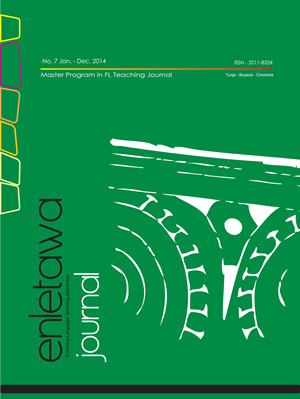The two fold role of pre-service teachers: their perceptions towards bilingualism in their future practices

Abstract
The aim of this study was to explore the perceptions of a group of pre-service teachers towards bilingualism and its role in their teaching practices. The participants came from two public universities who
participated in a set of focus groups. Their responses were validated with theoretical elements. In order to gain deeper understanding of data gathered the Grounded Theory methodology was used in the analysis of it. Findings evidence that the participants’ perceptions of bilingualism let them conceive themselves as having a twofold role in their future practices. This is sustained in two subcategories, the first: To be a bilingual master and the second: To be a bicultural reader.
References
- Bhatia, T.&Ritchie,C. (2004).The handbook of bilingualism. Chapetr 5. Bilinguals in Second Language Acquisition.
- Bloomfield, L. (1933). Language. London: Allen and Unwin.
- Brown, A. (2009) Students’ and Teachers’ PerceptionsofEffectiveForeign Language Teaching: A comparison of Ideals. The Modern Language Journal. Vol. 93, No. 1.
- Published by:Wiley on behalf of the National Federation ofModern Language Teachers Associations. Retrieved from http:// www.jstor.org/stable/40264128
- Bustos, B. (2001) Bilingual Education Teachers’ Beliefs and Their Relation to Self-Reported Practices. Bilingual Research Journal: The Journal of the
- National Association for Bilingual Education.Vol. 25, N° 3. Retrieved from
- http://www.tandfonline.com/doi/abs/10.1080/15235882.2001.10162795#. U3T8iPl5O2Y
- Butler, Y&Hakuta,K (2004)Bilingualismand second language acquisition. In: Bhatia, T & Ritchie, W (Eds.) The handbook of bilingualism. Malden, MA, Oxford:Blackwell Publishing. Denzin, N.K., Lincoln,Y.S. (1994). Handbook ofQualitative Research. Thousand Oaks; London: SAGE
- Fishman, J. A. (1965) Bilingualism, Intelligence and Language Learning. The Modern Language Journal . Vol. 49, No. 4 Published by: Wiley on behalf of the National Federation ofModern Language Teachers Associations. Retrieved from: http://www.jstor.org/stable/323298
- Garcia, O. (1997). Bilingual Education. In: Colmas, F. (Ed.) The handbook of Sociolinguistics. Massachusetts, USA:Blackwell Publishing.
- Guerrero, C. (2010). Elite Vs. Folk Bilingualism: The mismatch between
- theories and educational and social conditions. HOWa Colombian journal for teachers of English. Number 17. Bogotá, Colombia.
- Haugen, E. (1953). The Norwegian Language in America. Philadelphia:
- University of Pennsylvania Press.
- Kaplan, R. (2002). The Oxford Handbook of Applied Linguistics. New York: Oxford University Press.
- Lindlof, T. R., & Taylor, B. C. (2002). Qualitative Communication Research Methods, 2nd Edition. Thousand Oaks, CA: Sage.
- Pajares, M. F. (1992). Teachers’ beliefs and educational research: Cleaning up a messy construct. Review of Educational Research.
- Peal, E. and Lambert, W. E. (1962). The relation of bilingualism to intelligence. Psychological Monographs, 76, 1-23.
- Strauss, A & Corbin, J. (1990). Basics of Qualitative Research: Grounded Theory, Procedures and Techniques. California, USA: Sage Publications.
- William,M. &Burden, R. (1997), Psychology for language teachers: A social Constructional approach. Cambridge: Cambridge University Press.
Downloads
Download data is not yet available.